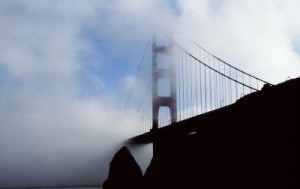 Originally published in Verbicide issue #21
Originally published in Verbicide issue #21
Easy There Tiger Productions/Koch Lorber Films
93 min., dir. by Eric Steel
Related Posts
The Golden Gate Bridge in San Francisco, CA is the most popular place in the world to commit suicide. In 2004 alone, the year in which the powerful documentary, The Bridge, was filmed, two-dozen people stepped over the bridge’s railings and leapt to their deaths. Filmmaker Eric Steel and his crew managed to (amazingly) record many of these suicides in an eerie, voyeuristic fashion that brought attention to suffering that previously went unnoticed. Often depressing but always ultra-fascinating, The Bridge may be one of the most haunting films you’ll ever see.
First time director Eric Steel grabs your attention from the very opening of the film. Even without the controversial theme of suicide, the Golden Gate Bridge by itself is an intriguing image. Standing like a giant in the fog, one glance at the mighty structure reveals the romantic appeal that draws those tired of life to end it with a flare that living did not provide. Scanning over the bridge’s walkway, we see average, normal looking people participating in activities that happen everyday on the California landmark: photo-ops, leisurely strolls, and those just enjoying the view. Then one man, who looks just as ordinary as the rest of the folks, calmly, almost casually, steps onto railing and jumps. Add an atmospheric track playing in the background and you’re glued until the final credits roll.
The film’s opener introduces a very important theme of the movie: people who choose to end their life often look like everybody else. For the rest of the film I found myself trying to guess who would jump every time they showed the bridge. As a complete stranger it was only possible to know for sure when the certain someone would make their first move up the railing. But Steel was not satisfied with just showing shock footage from a stranger’s point of view. Therefore, he successfully sought out those who knew the victims to share their thoughts to help the world gain a little more understanding of why some just can’t take it anymore. For most jumpers throughout the movie, Steel first shows the footage of their leap, and follows it with dialogue and interviews. Most effective, though, is a continuing narrative regarding one jumper whose suicide is not shown until the very end of the film, allowing the viewer to get to know the victim before witnessing their demise. In doing so, Steel creates a strong contrast in emotion to how we react to the first and last suicide we see in the film.
I can’t say that The Bridge answers the question, “Why do people kill themselves?” but it certainly came close to revealing why these particular subjects of the film made their decision. Each victim had their own story, and the range of emotions from those who knew them is quite vast. For those who may assume that this film is a constant sob-fest from the interviewees, I must say how surprised I was at how collected most of those who spoke were. In fact, I detected — dare I say — a coldness within a few of them that most likely spoke of their frustration at not understanding why their friend was so depressed. Regardless of how much they grasped of what led up to their loved ones decision, each tale transforms the image of a man or woman jumping into a life falling apart.
Perhaps the most interesting and impressive interview is with a person who chose to jump from the Golden Gate but survived. I will not reveal any of what this young man shares in the film, for his story is so remarkable that I feel it only fair that he tell it to you himself.
In fact, there is not much left to say about this film besides I hope you have the privilege of viewing it sometime soon. Suicide is a taboo subject and even now I find myself struggling to write even an innocent review without interjecting my own opinions about it. But The Bridge is objective, not leaving you with pro- nor anti-suicide messages, but simply reminding you that it’s there. Whether it angers or depresses you, or just makes you think for a moment, you won’t be able to deny how amazing it really is that what you just witnessed was captured on film. But due to the consistent rate of suicide at the Golden Gate Bridge, capturing these deaths was sadly easier than it should’ve been.